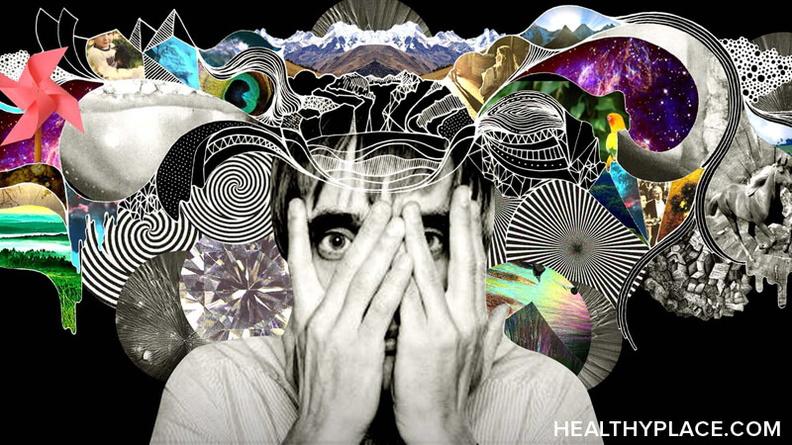Multi-Polar – The Many Moods of Bipolar Disorder

Recently a reader asked me to describe the moods of bipolar disorder in my own words. OK, I thought, but a lot has been written (by me and others) about depression, mania and hypomania before. But then I thought about it and realized that there were actually many moods in bipolar disorder and just saying there are “up” and “down” moods sort of does a disservice to everyone struggling with bipolar disorder.
Bipolar Disorder Moods List, Part One
Depression
Obviously depression is a major mood in bipolar disorder. Depression is experienced in many different ways. Yes, profound sadness is part of it but depression also often manifests as irritability and anhedonia (an inability to experience pleasure). Moreover, many physical symptoms accompany depression like lack of appetite (or greater appetite), lack of sleep (or more sleep), fatigue, the inability to think and oh, so much more. Depression drastically affects how one feels, thinks of themselves and sees the world. It also drastically affects their physical well-being.
Mania
Mania would seemingly be the opposite, but really that’s more like saying an apple is the opposite of an orange. Yes, manias are “up” while depressions are “down” but many of the symptoms aren’t opposites at all. For example, people in mania often don’t eat and don’t sleep – sound familiar? – they can also be excessively irritable and experience other bipolar mania symptoms. Mania also produces a rush of energy that manifests in the way a person acts and thinks. Mania, by definition, involves poor decision-making abilities resulting in actions that threaten the person suffering from mania or those around them. People with mania may suffer from psychosis (below).
![MP900438573[1]](/sites/default/files/uploads/2012/06/MP9004385731-1024x768.jpg) Hypomania
Hypomania
I am a fan of saying hypomania is mania light. It’s like all the taste of mania but with half the danger. People with hypomania experience a similar rush of energy and may not eat or sleep, but their judgement isn’t impaired to the point of endangering themselves (although their actions may lead to very negative consequences). Hypomania actually consists of all the same symptoms of mania but without the psychosis or lethal risk. Having hypomania and not mania puts you into the category of bipolar II instead of bipolar I.
Psychosis
Psychosis is a clinical term and is not used the way it is often used in popular culture (“that girl is psycho”). There is nothing inherently dangerous about a person experiencing psychosis, and in fact, many people without a mental illness will experience psychosis in their lifetime. Psychosis is simply the presence of delusions and/or hallucinations. Delusions and hallucinations frequently occur together. Psychosis is primarily associated with schizophrenia but can happen in bipolar mania too. Psychosis is known as a thought disorder as it affects your ability to create rational thoughts.
Psychotic Delusions
Delusions are strongly held beliefs in the face of contradictory evidence. For example, “the FBI is tracking my movements through the camera mounted on the next building” (there is a traffic camera there, see paranoia, in part 2). A delusion might be that someone is coming to kill you (a paranoid delusion) or that you are god (a delusion of grandeur) or that your organs are rotting (a somatic delusion). When someone experiences a delusion, the belief is so closely held that it is impossible to reason the person out of that belief.
Psychotic Hallucinations
Hallucinations are the sensation of something that isn’t there. Any sense can hallucinate – so you can see, smell, feel, hear or taste things that aren’t there. Commonly hallucinations are auditory or visual. Sometime people are aware they are hallucinating, sometimes they are not, but either way they may react as though the stimulus is completely real. Again, it’s generally impossible to reason someone out of a hallucination.
Part 2 will look at:
- Paranoia
- Anxiety
- Anger
- Overstimulation
- Suicidal Thoughts
Note: a great resource on what to do about psychosis symptoms is found here by the British Columbia Schizophrenia Society.
You can find Natasha Tracy on Facebook or GooglePlus or @Natasha_Tracy on Twitter.
APA Reference
Tracy, N.
(2012, June 28). Multi-Polar – The Many Moods of Bipolar Disorder, HealthyPlace. Retrieved
on 2025, December 31 from https://www.healthyplace.com/blogs/breakingbipolar/2012/06/multi-polar-many-moods-of-bipolar-disorder
Author: Natasha Tracy
Thank you Natasha. Yet another truly informative piece.
Don't forget mixed episodes. When those happen I feel like my skin is too tight.
I appreciate the way you specify the gray areas. I always feel inadequate when people ask me what it means to be bipolar.
I have Bipolar II. I'm new to blogging and reading blogs - and your site is one of the most informative and helpful I've come across. Thank you for your efforts to clarify what it means to have Bipolar. I can identify with so much of what you've written in this post alone.
Natasha:
Thanks so much for your excellent description of bipolar in Multi-Polar: The Many Moods of Bi-Polar Disorder.
It is one of the best explanations for the experience of manic depression that I have seen online.
Most descriptions are too simplistic for such a complicated disorder; leaving the reader with the idea that it is an either up or down state.
Your explanation shows the variety of symptoms that someone with bi polar can experience; either singly or in combination.
I believe that the labels of bipolar or manic depression fail to accurately describe the multisymptom nature of this troubling disorder.
Thanks for clarifying this baffling illness.
You're welcome all. Happy to help clarify where I can :)
- Natasha